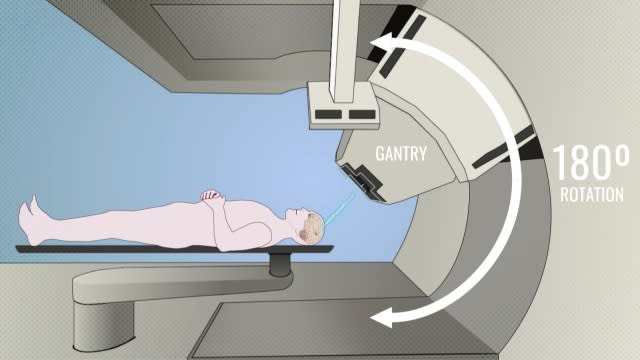High-dose proton radiation could shorten breast cancer treatment

Michelle Finley's cancer journey began in 2017 with stage 2 invasive ductal carcinoma — a type of breast cancer that starts in the milk ducts of a woman and moves into nearby tissue.
She told Scripps News about her hesitation to drive 70 miles from her home in the Minneapolis suburbs to the Mayo Clinic to get a second opinion, but says in hindsight she is grateful she did.
Doctors performed a mastectomy on Finley to remove two tumors in her left breast and reconstruct it after. She also qualified for a post-mastectomy clinical trial with the Mayo Clinic's proton beam therapy program.
Proton therapy, or proton radiation is still relatively new. The FDA approved it in 1988, and today numerous institutions are researching the long-term efficacy, side-effects and comparisons between it and conventional X-ray radiation.
In radiation treatment with high dose X-rays, wider beams kill cancer cells and shrink tumors, but also impact nearby healthy cells. With proton radiation, a device called a gantry moves around a patient while a "pencil-like" thin beam of intense protons go precisely to the cancer. With the reduced radiation exposure to surrounding tissue, there is a lower chance of damage occurring to healthy cells.
SEE MORE: New recommended age for breast cancer screenings
"Proton therapy is used especially in pediatrics. It's being used in brain tumors, head and neck cancers, and now increasingly also in breast cancer and prostate cancer," Mayo Clinic researcher and radiology oncologist Dr. Robert Mutter said.
Typically, proton radiation treatments last 25 sessions over five weeks. But Dr. Mutter’s recent research found that a higher dose in 15 sessions over three weeks is just as effective and had fewer skin side effects during and after treatment.
"If we can give the treatment in a shorter period of time, that may enable more patients to have access to proton therapy," Dr. Mutter told Scripps News.
Mayo is one of 42 proton therapy centers in the U.S., according to the National Association of Proton Therapy.
SEE MORE: Large new study links air pollution levels to breast cancer risk
High demand and price can be a barrier for many patients. The treatment can range from $20,000 to $100,000 and Medicare or insurance coverage varies.
"There's increasing access to it," Mutter said. "But we're still figuring out who are the optimal patients for this newer technology."
As for Michelle Finley, she just celebrated her 52nd birthday and remains part of the breast cancer survivor community online. She encourages others to get their mammograms. She also wants others to know that it's okay to get a second opinion, and that they're not alone.
"I would say in the beginning of my journey, every day you think about breast cancer, it's ...You can't hide the scars. You see it in the mirror every day. You think about it all the time. You think whether or not you're going to have a reoccurrence," she says. "As time goes by, I'm now a six-year survivor this month, and I don't think about it as much anymore. It's a part of me, but I don't think about it and I don't worry about it because I don't want to worry about something that may never happen."
